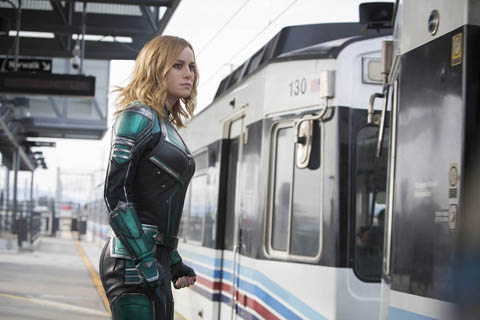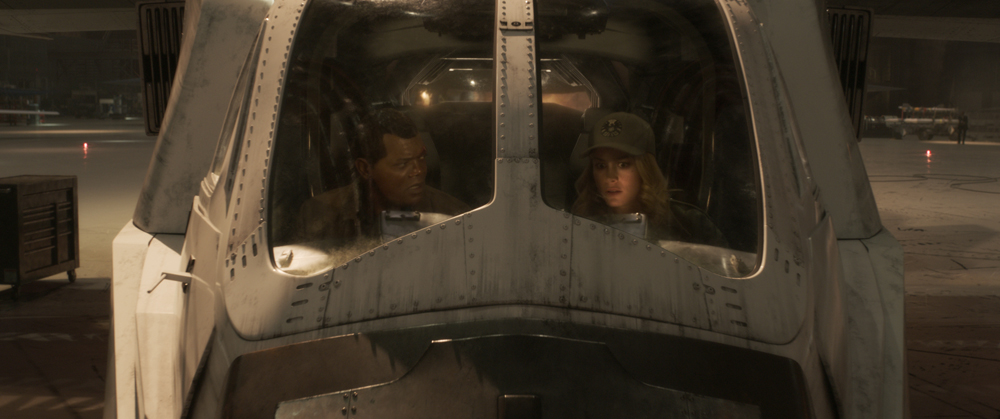For the better part of the past decade, Marvel Studios has successfully brought an entire universe of superheroes clad in colorful costumes and displaying amazing powers from comic books to the big screen. Whether it be their top tier heroes such as Captain America and Thor or more obscure ones like Ant-Man or the Guardians of the Galaxy, the “House of Ideas” has been able to create engaging motion pictures based off their printed properties. Still, in that same period of time, Marvel had yet to cast a solo spotlight on a female hero. That deficiency is finally answered with the release of Captain Marvel.
It is the year 1995, and on the homeworld of the warrior-heroes known as the Kree, the female Vers (Brie Larson) is uneasy. Even as she trains under Yon-Rogg (Jude Law), he cautions her against being too emotional in battle as this might lead to her undoing. Their unit, Starforce, is eventually assigned to address dubious activities on a planet that might be invaded by their enemies, the shape-shifting Skrulls. Starforce ends up in direct conflict with the Skrulls and Vers is captured and brought on their ship where they try to acquire information from her memories. Using her Kree powers, Vers escapes to a planet far from the Kree-Skrull conflict, Earth.

Vers crashes inside a Blockbuster Video with Skrulls pursuing her before she comes into contact with low level S.H.I.E.L.D. agents Nick Fury (Samuel L. Jackson) and Phil Coulson (Clark Gregg). The agents don’t buy Vers’ story that she’s from another planet until they too are copied and their identities used by the Skrulls against her. Fury eventually believes Vers as the latter receives disturbing flashbacks of memories that she has not thought of before Yon-Rogg awoke her from a coma just six years before. Dealing with the technology available in the mid-90s, Vers and Fury soon discover that she had been a US Air Force pilot named “Carol Danvers,” and that she was thought to have died while protecting Air Force scientist Wendy Lawson (Annette Bening).
These revelations, among others that Carol learns about herself and whom she believed to be her comrades, make her question herself and reassess what she thought was her life for the past six years. As she meets her one-time best friend Maria Rambeau (Lashana Lynch) and her daughter Monica (Akira Akbar), Carol gets her memories back, just in time to embrace the destiny in front of her.
As the final Marvel movie before the much-anticipated Avengers: Endgame in April, Captain Marvel faced the challenge of being a good picture on its own while also filling in some information before next month’s blockbuster. Directors Anna Boden and Ryan Fleck succeed in doing so because they experimented with the way they told this story by setting 98% of it in the 1990s and providing several plot twists that genuinely surprise the viewing audience.

Aware as they probably are of how many comic book fans know of the Kree-Skrull War, the Supreme Intelligence, and the original Mar-Vell, the filmmakers turn that same knowledge on its collective head and as a result, Captain Marvel is far more enjoyable than expected.
In Carol Danvers’ complicated history, she has used several superhero codenames. She began in 1968 as “Ms. Marvel” as she became a human-Kree hybrid after trying to be close to the original Captain Marvel, the Kree hero Mar-Vell. She would lose those abilities and instead gain the powers of a white dwarf star as the hero “Binary.” She eventually regained her original Ms. Marvel powers and rejoined the Avengers as “Warbird” and dealt with alcoholism. Carol returned to being Ms. Marvel before finally embracing her destiny as the successor to the hero Mar-Vell and became “Captain Marvel.”
It’s that complicated history with power changes and convoluted origins that are reflected in this film, albeit a lot more clearly. By altering how Carol gains her Kree powers, she still gets them from Mar-Vell but not for fawning after the male hero and instead in an act of self-sacrifice. This is comic revisionism for a film that works and credit has to be given to the filmmakers for it. By placing the film in the 1990s with the technology available then, they are able to introduce humor as well as a rocking soundtrack of music from the era. If Guardians of the Galaxy shone a light on 70s music, Captain Marvel does the same for the 90s.

Larson is of course, the lead in this film, but there are many scenes where it’s almost a buddy comedy as she and Jackson have great onscreen chemistry. It’s that relationship, largely built in the span of this entire motion picture, that gives gravitas to Fury’s previously seen intergalactic pager message to Carol at the end of Avengers: Infinity War. Law, for all of his good looks, is a dashing leading man as always, but you never get the sense that he’s flirting with Larson because they are military people and he’s molding her for other purposes. It’s those same qualities that makes the later twist in the story all the more enjoyable.
If Captain Marvel truly is Earth’s last hope against Thanos as Infinity War intimated, this was quite a way to introduce her to the world.
(Photos via Marvel Studios)
—
About the contributor:

Jason Inocencio was once the Digital Editor of adobo magazine who still loves seeing great campaigns from all over the world. He proudly shows off his love for all kinds of geeky things, whether it be movies, TV shows, comics, sports, or trivia.










